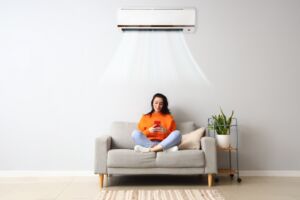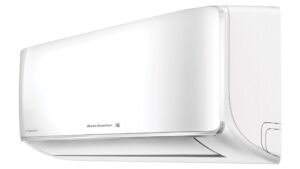As we well and truly start to step into winter, scrambling for a heating solution could possibly leave you with your wallet fairly empty. Luckily there’s a solution that can help save you money in the long run – reverse cycle air conditioning. With a two-in-one system, you’re also making an investment not only for winter but the following summer months. You can heat and cool your home with ease, but what else do you need to know about reverse cycle air conditioning for heating? Read on to find out more.
What is reverse cycle aircon?
Reverse-cycle air conditioning is a system that uses reverse-cycle technology to both heat and cool your home. It’s essentially two systems in one, and allows you to reverse the refrigeration cycle of your AC unit (hence the name ‘reverse cycle’) to produce heat instead of cooling. When the reverse cycle unit is in cooling mode, it works like a normal air conditioner.
How does reverse cycle air conditioning work?
Instead of using energy to create heat, reverse cycle air conditioners (also commonly known as heat pumps) simply pump heat from the outside air and bring it inside. Reverse cycle units produce heat using a refrigerant and external coil to absorb heat from outside which is then pumped through a compressor and into the condenser of your inside unit to warm your house. An added bonus of reverse-cycle air conditioners is that they can also filter and dehumidify the air in your home.

How much does reverse cycle air conditioning cost to run?
Reverse-cycle air conditioning is considered a cheaper heating alternative than portable heaters that run on gas or electricity. To help customers better understand their electricity and gas usage for this winter, Canstar Blue has put together a simple guide to heating costs to help you navigate the cooler months of the year without hiking up your energy bill.
Is reverse cycle aircon the most energy efficient heater?
Reverse cycle air conditioning can reach 300% to 600% efficiency, meaning it can take one unit of thermal energy and turn it into three to six times as much heating or cooling energy. With that being said, under mild conditions, some air conditioner products can reach over 1000% efficiency too. When it comes to choosing a type of heater that offers more bang for your buck, a reverse cycle air conditioner could be an ideal choice, but may depend on your climate and your needs.
How much does it cost to install a reverse cycle air conditioner?
The cost to install an air conditioner will vary depending on a number of factors. It comes down to the type of unit being installed, the brand, where it can be fitted and more. As a baseline for how much each type costs, we’ve broken down an estimated cost guide:
- Portable unit: $300- $1,000
- Window unit: $400-$1,100
- Split system/ multi-split: $400-$3,000
- Ducted system: $6,000- $12,000
Pros and cons of reverse cycle air conditioners
There are a number of pros and cons to any appliance, and reverse cycle air conditioning is no exception. Pros and cons include:
Pros:
- Generally cheaper to run and more energy efficient than portable electric heaters.
- Can help save money and space with a two-in-one system for heating and cooling all year round.
- Has no exposed elements or flames and remains cool to the touch.
- Can last up to 20 years before needing replacing, depending on usage and upkeep.
Cons:
- More expensive to purchase upfront and install than a portable heater.
- Higher running costs than evaporative systems.
- Heating capacity may begin to decrease when outdoor temperatures are extremely low.
- Doors and windows need to be kept closed for maximum efficiency.
- Outdoor units can be noisy.
Reverse cycle air conditioning vs other heater types

Reverse cycle air conditioners may not be the first choice people turn to for heating in winter if they don’t already have one installed. Other gas or electric portable heaters may be a simpler choice given the upfront costs are much smaller. But how do other portable heaters size up against a reverse cycle air con system?
- Reverse cycle system: 1kW of electricity consumed creates 3-4kW of heating.
- Gas heating: 1kW of gas burnt generates 1kW of heat.
- Electric heating: 1kW of electricity consumed produces 1kW of heating.
Speaking to its energy efficiency, recycle air conditioners come out on top in regards to energy consumption versus output. And given they produce a greater output of heating this can also mean that they cost less to run in the long term.
Should I buy a reverse cycle air conditioner?
Reverse cycle systems are more energy efficient than most other heating systems and much more environmentally friendly too. They’re easy to use and can heat large rooms and your home relatively easily, with the primary downside being that they can cost more to install and repair, but this will be offset by cheaper running costs. Plus, this type of system can potentially last you up to 20 years, potentially turning it into an investment . If you’re not sure about what else to consider when it comes to air conditioners, check out our latest air con ratings via the link below.
Picture credits: Butsaya, Shutterstock.com/ Andrey Popov, Shutterstock.com/ GSPhotography, Shutterstock.com/Kishivan, Shutterstock.com.


Share this article